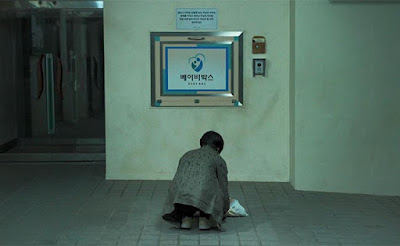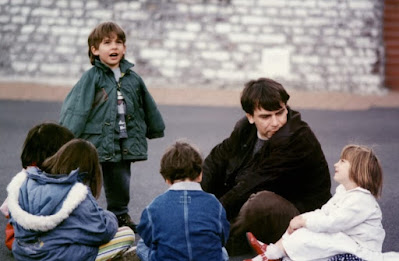Quotes from the film that provide glimpses of the thought-provoking script:
(Tár, being interviewed by Adam Gopnik in front of a live audience on Tár conducting Mahler’s Adagietto Symphony no.5)
Tár: And this piece was not born into aching tragedy. It was born into young love.
Gopnik (real life writer of New Yorker magazine): And you chose...
Tár: Love
Gopnik: Right, but precisely how long?
Tár: Well, seven minutes.
(That conversation could go beyond face value, if the viewer is familiar with Irving Wallace)
******
(On conducting a philharmonic orchestra)
Tár: Time is the thing.
Tár: You want to dance the mask. You must service the composer, you have got to sublimate yourself, your ego, and yes, your identity. You must, in fact, stand in front of the public and God, and obliterate yourself.
 |
| Tár (Cate Blanchett) rehearses while her wife and first violinist Sharon (Nina Hoss) is all attention |
Director and original screenplay writer Todd Field knows music well. He played the mysterious pianist Nick Nightingale in Stanley Kubrick’s Eyes Wide Shut. One of the undeniable strengths of the film’s script is the load of information and classical music trivia dumped through the engaging dialogs on why Lydia Tár (Cate Blanchett) wants Edward Elgar’s Cello Concerto to be performed as a companion piece to Mahler’s 5th symphony and those enlightening conversations between Tár and her former mentor Andris Davis (Julian Glover). However, in the film Tár only one movement—Trauermarsch– of the 5th symphony is played again and again in the film, including the crucial scene where Eliot Kaplan (Mark Strong) is conducting the Berlin Philharmonic Orchestra, replacing Tár as the conductor. Trauermarsch can be translated as Funeral March. It is a piece of music comparable to Beethoven's opening of his Fifth Symphony. One has to appreciate Todd Field, the screenplay writer and director for zeroing in on this piece of music that anticipates the tragedy of Lydia Tár's future with the fictional conductor ironically engrossed in Mahler's possible mood while recovering from near death in his real life. In the film, too, there is recovery for Lydia Tár's fall from hubris.
 |
| Much of the film's music revolves around the first movement of Mahler's Fifth symphony |
Tár is evidently very good at her job and has earned her position as the chief conductor of the Berlin Philharmonic Orchestra and is presented to us by the screenplay as the first woman to be chief conductor of a major orchestra and thus constantly addressed as “maestro.” All the members of her orchestra are in awe of her talents and respect her. As the film progresses, we are informed that she had humble beginnings but her talent and ear for classical music was only too evident and went on to win medals. As the film constantly provides examples of her ear for music and her talent for conducting, we continue to be fascinated by the successful and not-so-successful times of Tár's career.
 |
| Tár rehearses with the orchestra, which is often when she gets her creative juices to flow |
In the
film, Ms Blanchett switches from spoken English to spoken German and back with felicity as
she rehearses with members of the Berlin Philharmonic Orchestra. Blanchett
possibly knew she could do a great job if cast in the main role. It is therefore not
surprising that she took on the role of the executive producer of this film as well. She
even writes the mocking lyrics of a song that she sings in the film about a
middle-class neighbor next door who sells and moves out because of her constant
musical activities often involving piano and other musical instruments.
Though
the film’s tale is about LGBT characters there are few sexual encounters on
screen save for kisses between Tár and her wife Sharon (Nina Hoss, who made an major impact in the early films of the German filmmaker, Christian Petzold) and a hug with Krista Taylor. The LGBT
elements might move forward the plot of the film Tár but they are not the mainstay of Todd Field’s film; instead,
the film Tár focuses on music and the
mental state of the maestro. When the carpet under Lydia Tár is pulled at the
zenith of her career for her sexual appetite rather than her musical skills,
screenplay-writer and director Todd Field dishes out elements of Eyes Wide Shut—recollection of past
events, masks, mystery and fringe characters that are crucial (such as Krista Taylor) who we never get to
study beyond a rear-head shot listening to the opening interview or in a
short dream sequence. The script leads us instead to study the effects such individuals eventually
have on Lydia, an alleged sexual predator. Another such fringe character is
Lydia/Linda Tár’s mother, who too, is never discussed at length—similar to the
treatment Kubrick gave to several fringe characters in Eyes Wide Shut.
 |
| The mysterious lady in the audience that the director highlights: is it Krista Taylor,who later commits suicide? |
The
maestro Tár is shown as a top-notch conductor mentored in the past by an
elderly famous conductor Andris Davis, who eventually avoids her, when she has
lost her fame. Another conductor who Tár
evidently was influenced by is Leonard Bernstein (we are shown her replaying a
video of Bernstein that has tips on conducting). Tár is shown bullying an aspiring male music
conductor called Max at a Julliard class where she is a guest teacher. Off and
on screen we know she bullied and could even wreck the careers of female
conductors who aspired to move up. Thankfully the movie is more about music than about sex. Interestingly, Todd Field’s screenplay
includes Tár making a jibe at Jerry Goldsmith’s score of Planet of the Apes during the Julliard class. The script is indeed a
delightful trivia trough for music lovers.
 |
| A distinguished conductor, Andris Davis (Julian Glover) often mentors Tár, until her rapid fall from grace |
 |
| Tár, the human metronome. who prides in managing time is disturbed at home by the mechanical metronome and rushes to stop it: Field's script indicates that all is not well with the maestro's mind |
 |
| Past lovers wonder if Tár has a conscience |
Beyond music, the amazing script explores the mind of the talented maestro, who is introduced to us as a maestro, who gives the highest of importance to “time” in the musical pieces that she controls with her baton in the right hand, unlike the shapes of music controlled by her empty left hand. Tár's character is developed by director Field as a human metronome. When Blanchett’s life is unwinding, she is disturbed by a sound--seemingly marking rhythmic time, which she goes searching for in her apartment to get rid off, including searching her refrigerator, only to discover a regular metronome kept hidden in a shelf, which she stops. The metronome is symbolically crucial to the film because Tár, the ultimate alpha female, during the Julliard guest lecture called the aspiring conductors, like Max, who did not toe her line, “robots” while in the film's finale the once-perfect and creative Tár is reduced to be a robotic conductor in an unspecified Asian country, despite her innate creative talent. In the Julliard lecture (for those who notice editing details, the entire lecture is filmed in a single unstitched take) shown earlier in the film, Tár points out to Max that the sexual life of Bach (who apparently sired 20 or more kids) is not a barometer to judge a composer’s worth but by his creative work in the world of music. It is ironic, in the context of her own statements during the lecture, that the eventual downfall of Tár was her sexual life and its consequences, rather than her awesome ability to conduct music.
In the words of Cate Blanchett (quoted on the IMDb website): "Tár speaks to a moment in a woman's life when she is moving inexorably, as we all are, towards death, and we try to outrun that very thing--we try to outrun that unpalatable side of ourselves. We try to hide." Now moving towards death is what the opening movement, Funeral March, of Mahler's 5th symphony is all about. So, too, is the reference of likely chance of losing your life (if you were enticed to swim) to the deadly crocodiles introduced into an Asian river for shooting of Apocalypse, Now--the Marlon Brando film alluded to in the screenplay.
Cineastes could compare and contrast Todd Field's Tár with the recent French film France (2021) directed by Bruno Dumont, based on Dumont's original screenplay, where Lea Seydoux plays a star TV personality also falling rapidly from her zenith of popularity. Lea Seydoux, like Cate Blanchett in Tár, gives one of her best performances in the French film. Similarly, the original scripts of Field and Dumont, and the original music in both the films, offer much to be compared and contrasted with each other.
P.S. Tár won the Best Actress award for Ms Cate
Blanchett at the Venice international film festival in 2022, BAFTA Awards (UK) and at the Golden Globes 2023 (USA). Ms Blanchett has
collected similar awards at two US international film festivals. Tár won
the prestigious Camerimage’s Golden Frog
award for cinematography for the contributions of Florian Hoffmeister
and Todd Field. Director Todd Field also won the Gotham Independent Film Award
for Best Screenplay. Actresses Cate Blanchett and Nina Hoss are among the
author’s favorite 14 actresses of the 21st century.































